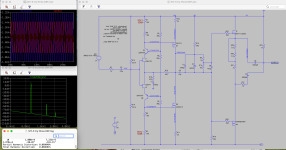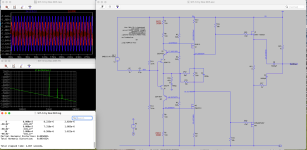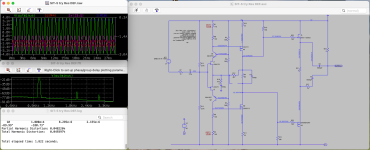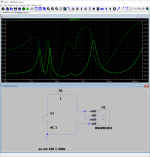To adjust the midpoint of the OS, or better said to adjust the vds on j3 it would be best to add a rc(trimmer + cap) network in series with R13 and then adjust for maximum power or best thd.
Like I mentioned from the beginning I do believe that the power resistors on the sit pcb are used for drain current sensing but this time we already know its an interesting circuit.
I am listening to something similar, with the OS having same ratios as here and I can tell the sound worths all the troubles.
Very powerful, detailed and fat sound!
Like I mentioned from the beginning I do believe that the power resistors on the sit pcb are used for drain current sensing but this time we already know its an interesting circuit.
I am listening to something similar, with the OS having same ratios as here and I can tell the sound worths all the troubles.
Very powerful, detailed and fat sound!
Papa, has always been big on linearity for Zout in this regard so that even when a loudspeaker presents an unkind impedance profile the amplifier does well.No speaker is exactly 4 Ohm or 8 Ohm over the whole frequency range, or even 4 Ohm or 8 Ohm at any frequency.
There are all sorts of assumptions and compromises in design, and the designer makes choices to suit his goals and preferences.
Ben, did you apply the cap trick your SIT follower to see what it does?I have no doubt that it will be better than anything that I have done.
No.
I am happy enjoying the music and the heat as is. 🤓
I am happy enjoying the music and the heat as is. 🤓
Here is the SIT-5 complementary bias circuit with my SIT-3X Xpot included.
The SIT-5 becomes the a version if the SIT-3X with the addition of the electrolytic capacitor trick and the addition of R2, which becomes unnecessary.

The SIT-5 becomes the a version if the SIT-3X with the addition of the electrolytic capacitor trick and the addition of R2, which becomes unnecessary.
So depending on the adjustment you have on the xpot, the OS will work as DEF(the output current is the difference of Sit current and mos current) or sepp(the output current is the sum of Sit and mos current) if my understanding is correct.
These days I did a few real tests having the modulation resistor not bypassed.
For 35w/8r a bias of 2.2a is enough to get 0.9% thd with 20% mosfet modulation and a nice stairway falling thd profile being h2 dominant.
At 4r.. the story changes if you want to get 60w.
I upped the bias at 2.8a but at 10w the amp is already 3hd dominant. And with 20% mos modulation you get only 34w at 0.9%
To get 60w/4r you have a few options:
-increase the bias but because you are already at the maximum dissipation limit you won’t be able to up it so high to make the amp h2 dominant
- increase mosfet modulation to 40%. Like this it can get you 1% thd at 60w but still not a h2 dominant amp. I listened with the amp like this and didn’t like very much the sound even if on paper its looking better the sound dries up.
-add Pa’s trick to get square law behavior. This one being the best approach.
With 8r speakers square law is good to have but its not a must instead with 4r speakers it is needed.
Previously I had 3.4r/89db speakers and I played with the above OS in the spring.
Because those were low impedance and power hungry, at that time I needed to set the amp for 50% mos modulation to get some power to move them. Didn’t like the sound at all and placed the circuit in the drawer until now when Pa said about the 20% mos modulation and made me curios to try again the amp this time with the lower modulation.
Fortunately for me, thanks to ZM, this time I was prepared better with the speakers, 6r/96db.
For a few days I listened with 20% mos modulation and was very pleased with the sound.
Yesterday being eager to get more power at 4r(even if not needed) I upped the mos modulation to 40%.
It played only a few tracks and the modulation went back to 20%.
These days I did a few real tests having the modulation resistor not bypassed.
For 35w/8r a bias of 2.2a is enough to get 0.9% thd with 20% mosfet modulation and a nice stairway falling thd profile being h2 dominant.
At 4r.. the story changes if you want to get 60w.
I upped the bias at 2.8a but at 10w the amp is already 3hd dominant. And with 20% mos modulation you get only 34w at 0.9%
To get 60w/4r you have a few options:
-increase the bias but because you are already at the maximum dissipation limit you won’t be able to up it so high to make the amp h2 dominant
- increase mosfet modulation to 40%. Like this it can get you 1% thd at 60w but still not a h2 dominant amp. I listened with the amp like this and didn’t like very much the sound even if on paper its looking better the sound dries up.
-add Pa’s trick to get square law behavior. This one being the best approach.
With 8r speakers square law is good to have but its not a must instead with 4r speakers it is needed.
Previously I had 3.4r/89db speakers and I played with the above OS in the spring.
Because those were low impedance and power hungry, at that time I needed to set the amp for 50% mos modulation to get some power to move them. Didn’t like the sound at all and placed the circuit in the drawer until now when Pa said about the 20% mos modulation and made me curios to try again the amp this time with the lower modulation.
Fortunately for me, thanks to ZM, this time I was prepared better with the speakers, 6r/96db.
For a few days I listened with 20% mos modulation and was very pleased with the sound.
Yesterday being eager to get more power at 4r(even if not needed) I upped the mos modulation to 40%.
It played only a few tracks and the modulation went back to 20%.
- Home
- Amplifiers
- Pass Labs
- First Watt SIT5







